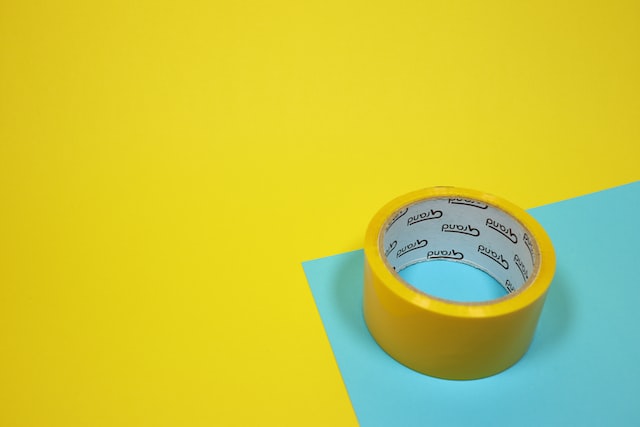Adhesives are used to join two surfaces together, while sealants are used to fill gaps and prevent leaks.
Adhesive
(Photo by Lucas Dudek on Unsplash )

An adhesive is a material that bonds two surfaces together. Adhesives may be used in a variety of applications, including bonding two pieces of material together, such as in woodworking or paper crafts. Adhesives may also be used to seal a surface, such as in sealing an envelope.
Adhesives are usually made from materials like glue or resin, Adhesives bond surfaces together by chemical reaction. Adhesives are stronger than sealants.
Sealant
A sealant is a material that is used to fill gaps or cracks. Sealants are typically used in applications where a watertight or airtight seal is desired, such as in caulking a window or door, and to prevent the passage of fluids or gases
Sealants are made from materials like silicone or latex. Sealants bond surfaces together by mechanical action. Sealants are not as strong as adhesives.
Sealants are typically adhesives, but there are also non-adhesive sealants available. Adhesive sealants are typically made from silicone, urethane, or acrylic materials, while non-adhesive sealants can be made from materials such as polyurethane or latex.
What is the difference between an adhesive and a sealant?
An adhesive and a sealant are both used to join two surfaces, but there are some key differences between the two:
Function:
An adhesive is used to join two surfaces together and create a strong, permanent bond between them. Adhesives are designed to withstand stress and strain, and are typically used in applications where a strong bond is required.
A sealant, on the other hand, is used to create a barrier between two surfaces to prevent the passage of air, water, or other substances. Sealants are used to fill gaps, cracks, and joints, and can be applied to a wide variety of materials, including wood, metal, glass, and plastic.
Composition:
Adhesives are typically made of a combination of synthetic or natural polymers, solvents, and other additives that give them their bonding properties. Adhesives can be categorized based on their chemical composition, such as epoxy, cyanoacrylate, or polyurethane.
Sealants are typically made of a combination of synthetic or natural polymers, solvents, and other additives that give them their sealing properties. Sealants can be categorized based on their chemical composition, such as silicone, polyurethane, or acrylic.
Application:
Adhesives are typically applied to one or both surfaces that are being joined together, and then the surfaces are pressed together to create the bond. Adhesives can be applied using a variety of methods, such as spraying, brushing, or rolling.
Sealants are typically applied to a surface to fill gaps, cracks, or joints. Sealants can be applied using a variety of methods, such as caulking, troweling, or spraying.
The main difference between an adhesive and a sealant is their function. Adhesives are used to join two surfaces together to create a strong, permanent bond, while sealants are used to create a barrier between two surfaces to prevent the passage of air, water, or other substances.
What are the different types of adhesives?
There are many types of adhesives available, each with its own unique properties and uses. Here are some common types of adhesives along with examples and their uses:
Acrylic Adhesives:
Examples: Acrylic hot melt adhesive, acrylic emulsion adhesive, cyanoacrylate adhesive
Uses: These adhesives have good bonding strength and are often used for joining plastics, glass, and metals. They are also used in the automotive and construction industries.
Epoxy Adhesives:
Examples: Two-part epoxy adhesive, one-part epoxy adhesive
Uses: Epoxy adhesives have strong bonding properties and are often used for industrial applications such as metal bonding, composite bonding, and electronic assembly.
Polyurethane Adhesives:
Examples: One-part polyurethane adhesive, two-part polyurethane adhesive
Uses: Polyurethane adhesives have good bonding strength and are often used in the construction industry for bonding wood, metal, and plastic materials.
Cyanoacrylate Adhesives:
Examples: Super glue
Uses: Cyanoacrylate adhesives have fast bonding properties and are often used for bonding small objects such as jewelry, electronics, and plastics.
Hot Melt Adhesives:
Examples: Hot glue sticks, hot melt film adhesive
Uses: Hot melt adhesives are thermoplastic adhesives that are often used in the packaging and woodworking industries.
Pressure-sensitive Adhesives:
Examples: Adhesive tapes, labels, decals
Uses: Pressure-sensitive adhesives have low bonding strength and are often used for temporary bonding of materials such as paper, plastic, and fabric.
Silicone Adhesives:
Examples: One-part silicone adhesive, two-part silicone adhesive
Uses: Silicone adhesives are often used for bonding glass, metal, and plastic materials in the automotive and construction industries.
Synthetic Rubber Adhesives:
Examples: Neoprene adhesive, nitrile adhesive, butyl adhesive
Uses: Synthetic rubber adhesives have good bonding strength and are often used for bonding rubber, leather, and plastic materials.
These are just a few examples of the many types of adhesives available, each with its own unique properties and uses. The specific type of adhesive that should be used will depend on the materials being bonded and the requirements of the application.
What are the different types of sealants?
There are many types of sealants available, each with its own unique properties and uses. Here are some common types of sealants along with examples and their uses:
Silicone Sealants:
Examples: RTV silicone, neutral-cure silicone, high-temperature silicone
Uses: Silicone sealants are used to seal gaps, cracks, and joints in a wide range of materials, including glass, metal, plastic, and ceramics. They are often used in the construction and automotive industries.
Acrylic Sealants:
Examples: Acrylic latex sealant, acrylic elastomeric sealant
Uses: Acrylic sealants are often used for sealing gaps and cracks in wood, metal, and masonry surfaces. They are typically used in the construction industry.
Polyurethane Sealants:
Examples: One-part polyurethane sealant, two-part polyurethane sealant
Uses: Polyurethane sealants are often used for sealing joints in concrete, metal, and wood structures. They have good bonding strength and can be used for both interior and exterior applications.
Butyl Sealants:
Examples: Butyl tape, butyl sealant
Uses: Butyl sealants are used for sealing roofs, windows, and doors. They have good water resistance properties and are often used in the construction industry.
Epoxy Sealants:
Examples: Two-part epoxy sealant
Uses: Epoxy sealants are often used for sealing cracks and joints in concrete, metal, and wood structures. They have good bonding strength and are often used in the construction and automotive industries.
Polyisobutylene Sealants:
Examples: Polyisobutylene sealant
Uses: Polyisobutylene sealants are used for sealing roofs, windows, and doors. They have good water resistance properties and are often used in the construction industry.
Polysulfide Sealants:
Examples: Polysulfide sealant
Uses: Polysulfide sealants are used for sealing joints in concrete, metal, and wood structures. They have good chemical resistance properties and are often used in the construction industry.
What are the advantages and disadvantages of adhesives?
Adhesives offer many advantages over other types of fasteners and bonding methods, but they also have some disadvantages. Here are some of the advantages and disadvantages of using adhesives:
Advantages:
- Strong bonding: Adhesives can form strong and durable bonds between a wide range of materials, including plastics, metals, ceramics, and wood.
- Wide range of applications: Adhesives can be used in a variety of applications, such as in construction, automotive, electronics, and woodworking.
- Aesthetics: Adhesives can create clean and smooth surfaces, without the unsightly appearance of screws or nails.
- Reduced weight: Adhesives are lighter than traditional fasteners such as bolts or screws, which can be advantageous in certain applications.
- Can fill gaps and irregular surfaces: Adhesives can be used to fill gaps and irregular surfaces, which can be difficult with other types of fasteners.
Disadvantages:
- Limited repositioning: Once an adhesive has bonded, it is difficult to reposition the parts being bonded.
- Curing time: Some adhesives require a long time to cure before the bond is fully developed.
- Bond strength may be affected by temperature: Adhesives may lose their bonding strength at high temperatures, and may become brittle and crack at low temperatures.
- Chemical sensitivity: Some adhesives may be sensitive to certain chemicals, which can weaken or destroy the bond.
- Health and safety: Some adhesives may contain harmful chemicals or fumes, and may require special precautions to ensure safe use.
The selection of an adhesive should be based on the specific requirements of the application and materials being bonded, as well as safety considerations.
What are the advantages and disadvantages of sealants?
Sealants offer many advantages over other methods of sealing and bonding, but they also have some disadvantages. Here are some of the advantages and disadvantages of using sealants:
Advantages:
- Flexibility: Sealants are often flexible and can accommodate movement and vibration in materials.
- Water resistance: Many sealants have good water resistance properties, which can prevent water from seeping into structures and causing damage.
- Aesthetics: Sealants can create a clean and smooth surface, which can be advantageous in applications where appearance is important.
- Wide range of applications: Sealants can be used in a variety of applications, such as in construction, automotive, and marine industries.
- Easy application: Sealants can be easily applied to surfaces with a caulking gun, spray, or brush.
Disadvantages:
- Curing time: Some sealants require a long time to cure before the bond is fully developed.
- Bond strength may be affected by temperature: Some sealants may lose their bonding strength at high temperatures, and may become brittle and crack at low temperatures.
- Limited strength: Sealants are often not as strong as adhesives or mechanical fasteners, and may not be suitable for heavy loads or high-stress applications.
- Limited gap-filling capability: Sealants may not be able to fill large gaps or irregular surfaces as effectively as other types of sealants or adhesives.
- Chemical sensitivity: Some sealants may be sensitive to certain chemicals, which can weaken or destroy the bond.
Sealants offer many benefits for sealing materials, but also have some drawbacks to consider. The selection of a sealant should be based on the specific requirements of the application and materials being sealed, as well as safety considerations.
What are the differences in composition between adhesives and sealants?
Adhesives and sealants are both materials that are used to bond or seal materials together, but they differ in their chemical composition. Adhesives are typically made from synthetic or natural polymers, which are formulated to provide strong bonding properties. The most common types of polymers used in adhesives include acrylics, epoxies, polyurethanes, and cyanoacrylates. Adhesives may also contain other chemicals, such as solvents, fillers, or stabilizers, to improve their performance or handling.
Sealants, on the other hand, are formulated with the primary goal of providing a barrier or seal between two surfaces. They are typically made from a variety of materials, such as silicone, polyurethane, polysulfide, or modified bitumen. These materials are designed to have a low viscosity, which allows them to flow into small gaps and irregular surfaces, creating a tight seal. Sealants may also contain other chemicals, such as curing agents, thickeners, or adhesion promoters, to enhance their performance.
The main difference in the composition of adhesives and sealants is that adhesives are formulated to provide a strong bond between two surfaces, while sealants are formulated to provide a barrier or seal. Adhesives are often more viscous and are used to fill gaps between two surfaces, while sealants are typically less viscous and are used to seal gaps or joints. Adhesives are typically used in high-stress applications, where strong bonding is required, while sealants are used in applications where preventing the entry of moisture or air is important.
Photo by Jo Szczepanska on Unsplash








